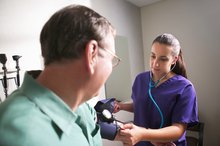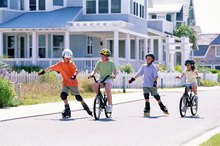What does fact checked mean?
At Healthfully, we strive to deliver objective content that is accurate and up-to-date. Our team periodically reviews articles in order to ensure content quality. The sources cited below consist of evidence from peer-reviewed journals, prominent medical organizations, academic associations, and government data.
- American Heart Association: Learning For Life Physical Education in Public Schools
- The President's Council on Physical Fitness and Sports: The Benefits of Physical Activity
- American College of Sports Medicine: President Obama Urged to Prioritize Physical Activity; March 2009
- American College of Sports Medicine: President Obama Urged to Prioritize Physical Activity; March 2009
The information contained on this site is for informational purposes only, and should not be used as a substitute for the advice of a professional health care provider. Please check with the appropriate physician regarding health questions and concerns. Although we strive to deliver accurate and up-to-date information, no guarantee to that effect is made.
Why Should High School Kids Take Gym Every Year?
Physical education, or gym class, isn't mandatory for all high school students. In some schools, it isn't offered due to budget cuts or the idea that students should use that time to study. Physical education may actually increase academic performance. It also teaches teens skills and habits that help them transition to healthy adults.
Establishing Healthy Habits
Obese and sedentary teens are likely to carry their bad habits into adulthood. Teaching teens the importance of a healthy lifestyle and establishing fitness routines now can help teens make exercise a priority as an adult. Teens can also learn to use exercise as a healthy coping mechanism for academic and social stress. Physical activities, such as group sports, help build adult leaders and teach teens the value of teamwork and cooperation.
- Obese and sedentary teens are likely to carry their bad habits into adulthood.
- Teens can also learn to use exercise as a healthy coping mechanism for academic and social stress.
Weight Control
Reasons for Lack of Exercise in Teens
Learn More
The American Heart Association is an advocate for physical education to help reduce childhood obesity 2. AHA estimates that 10 million kids and teens suffered from obesity as of 2011. Teens should get 60 minutes of physical activity per day to control their weight and to strengthen bones and muscles. The increase in sedentary activities among teens, such as video games and computer activities, means many teens don't get their required exercise. Physical education classes act as a public health measure to encourage activity and help teens maintain healthy weights.
- The American Heart Association is an advocate for physical education to help reduce childhood obesity 2.
- The increase in sedentary activities among teens, such as video games and computer activities, means many teens don't get their required exercise.
Reduced Disease Risk
Inactivity and obesity increases the risk that teens will develop heart disease, diabetes, bone and joint problems and certain cancers as adults. An active lifestyle offers a substantial means of protection from these and many other preventable chronic health problems. On a global scale, widespread obesity-related disease prevention could save the Unites States billions of dollars in health care costs. As much as 75 percent of health care spending goes toward treating medical conditions that can be prevented with lifestyle changes, according to the American College of Sports Medicine.
- Inactivity and obesity increases the risk that teens will develop heart disease, diabetes, bone and joint problems and certain cancers as adults.
- On a global scale, widespread obesity-related disease prevention could save the Unites States billions of dollars in health care costs.
Improved Academic Performance
Exercise Facts for Kids
Learn More
According to the President's Council on Physical Fitness and Sports, students who performed five hours of physical activity each week improved their academic performance, alertness levels and attention spans. Students from programs with no physical activity who used the extra time for classroom study did not perform better on standardized tests than the students who gave up some study time in favor of physical education. The PCPFS also reports that brain scans of students who get regular exercise show increased activity in the parts of the brain required for learning and decision making.
- According to the President's Council on Physical Fitness and Sports, students who performed five hours of physical activity each week improved their academic performance, alertness levels and attention spans.
- The PCPFS also reports that brain scans of students who get regular exercise show increased activity in the parts of the brain required for learning and decision making.
Related Articles
References
- U.S. Centers for Disease Control and Prevention: How Much Physical Activity Do Children Need?
- American Heart Association: Learning For Life Physical Education in Public Schools
- American College of Sports Medicine: President Obama Urged to Prioritize Physical Activity; March 2009
- Centers for Disease Control and Prevention. Physical activity: Children. Updated April 10, 2020.
- Harvard School of Public Health. The nutrition source, physical activity guidelines: How much exercise do you need? Updated November 20, 2013.
- KidsHealth by Nemours. Fitness and your 13-to 18-year old. Updated June 2019.
Writer Bio
A Jill-of-all-trades, Lillian Downey is a certified Responsible Sexuality Educator, certified clinical phlebotomist and a certified non-profit administrator. She's also written extensively on gardening and cooking. She also authors blogs on nail art blog and women's self esteem.









